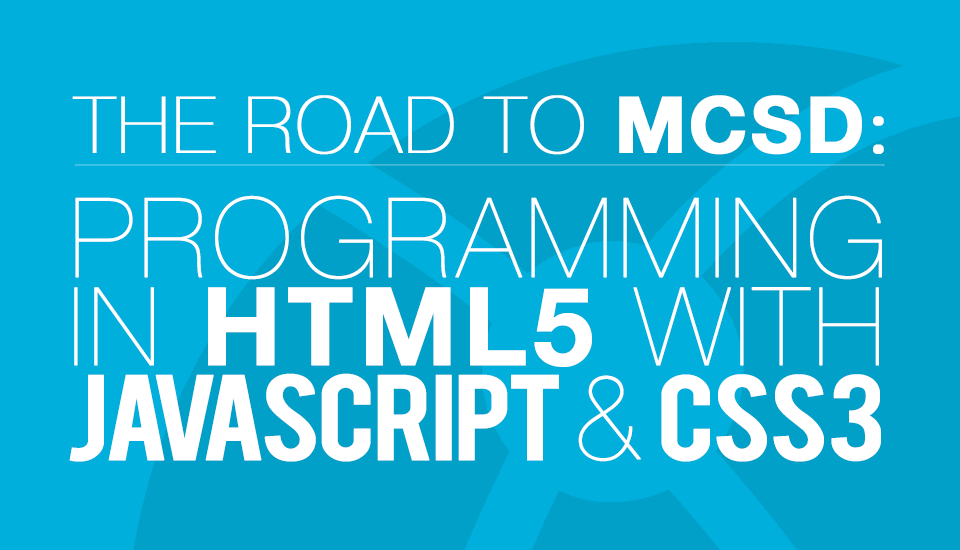The 70-480 exam is a detailed examination of your skills with using HTML5 and CSS3. This book will guide you through the necessary objectives that you are expected to know to pass this exam. It is expected that you have at least 2 years’ experience working with these technologies. This book is structured such that it provides a reference to the key information required for each objective. This book does not teach every concept but provides an account of the details you are expected to know for each objective covered on the exam.

This book covers every exam objective, but it does not cover every exam question. Only the Microsoft exam team has access to the exam questions themselves and Microsoft regularly adds new questions to the exam, making it impossible to cover specific questions. You should consider this book a supplement to your relevant real-world experience and other study materials. If you encounter a topic in this book that you do not feel completely comfortable with, use the links you’ll find in text to find more information and take the time to research and study the topic. Great information is available on MSDN, TechNet, and in blogs and forums.
Microsoft certifications
Microsoft certifications distinguish you by proving your command of a broad set of skills and experience with current Microsoft products and technologies. The exams and corresponding certifications are developed to validate your mastery of critical competencies as you design and develop, or implement and support, solutions with icrosoft products and technologies both on-premise and in the cloud. Certification brings a variety of benefits to the individual and to employers and organizations.
Preparing for the exam
Microsoft certification exams are a great way to build your resume and let the world know about your level of expertise. Certification exams validate your on-the-job experience and product knowledge. While there is no substitution for on-the-job experience, preparation through study and hands-on practice can help you prepare for the exam.
We recommend that you round out your exam preparation plan by using a combination of available study materials and courses. For example, you might use this Exam Ref and another study guide for your "at home” preparation and take a Microsoft Official Curriculum course for the classroom experience. Choose the combination that you think works best for you.
Note that this Exam Ref is based on publicly available information about the exam and the author’s experience. To safeguard the integrity of the exam, authors do not have access to the live exam.
Access and secure data
Most web applications require static or dynamic data. Static data is written directly into the HTML markup, not altered or loaded by code such as JavaScript. It’s rendered and displayed to users without any way for the data to change. Dynamic data can change. Dynamic data can update a ticker on a webpage from a news feed, capture user data to perform an operation and provide results, or perhaps even store just a user’s registration information in a database.
Both approaches to data have benefits as well as disadvantages. Static data is quite secure because it doesn’t provide much of an attack surface for a malicious user. However, as a website transitions into a more dynamic site, with live updates of data and the ability for users to enter information into various fields, an attack surface opens and the site can become less secure.
Knowing how to prevent malicious users from causing harm to your application and possibly your users is important. You can implement the same mechanisms used to prevent malicious usage to simplify the user experience and to keep your data generally clean. Certain data elements, such as phone numbers and email addresses, can be provided in different formats. Because such information can be very important, you want to make it as easy as possible for users to enter it. Having complete address information and ensuring that all the necessary fields are populated also can be very important. HTML5 supports constructs such as regular expressions and required attributes to support implementing these types of rules. Throughout the objectives in this chapter, validating user input both declaratively via HTML5 and also by using JavaScript is covered.
In other scenarios, data coming to and from the website is either consuming data feeds or providing data to another destination. Websites today commonly have a direct link to social networking updates. In these cases, the retrieving and sending of the data is invisible in that users aren’t engaged with the process. These processes should be streamlined and not interfere with the website’s user experience. In this chapter’s objectives, consuming data from external sources, transmitting data, and serializing and deserializing data are all covered.
Objectives in this chapter:
- Objective 3.1: Validate user input by using HTML5 elements
- Objective 3.2: Validate user input by using JavaScript
- Objective 3.3: Consume data
- Objective 3.4: Serialize, deserialize, and transmit data
No comments:
Post a Comment